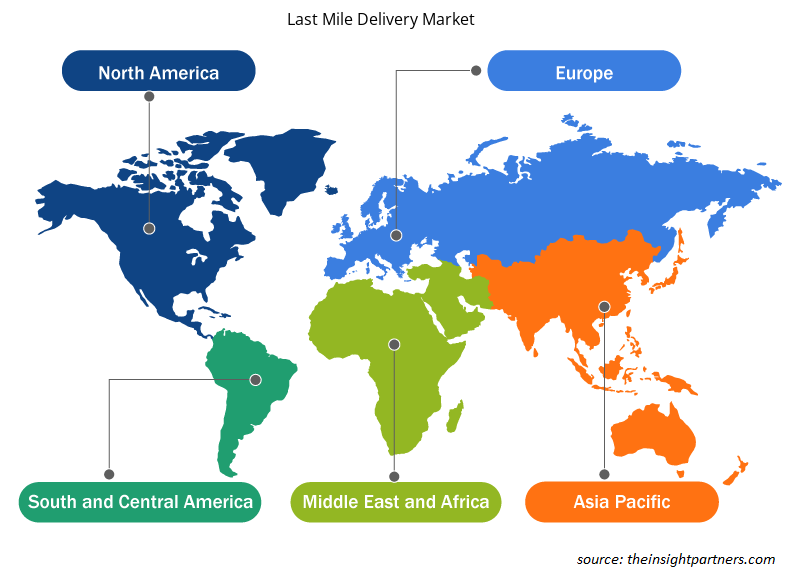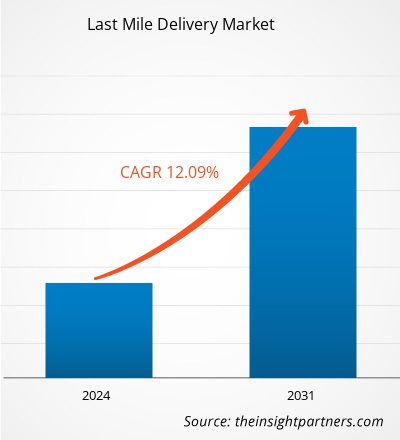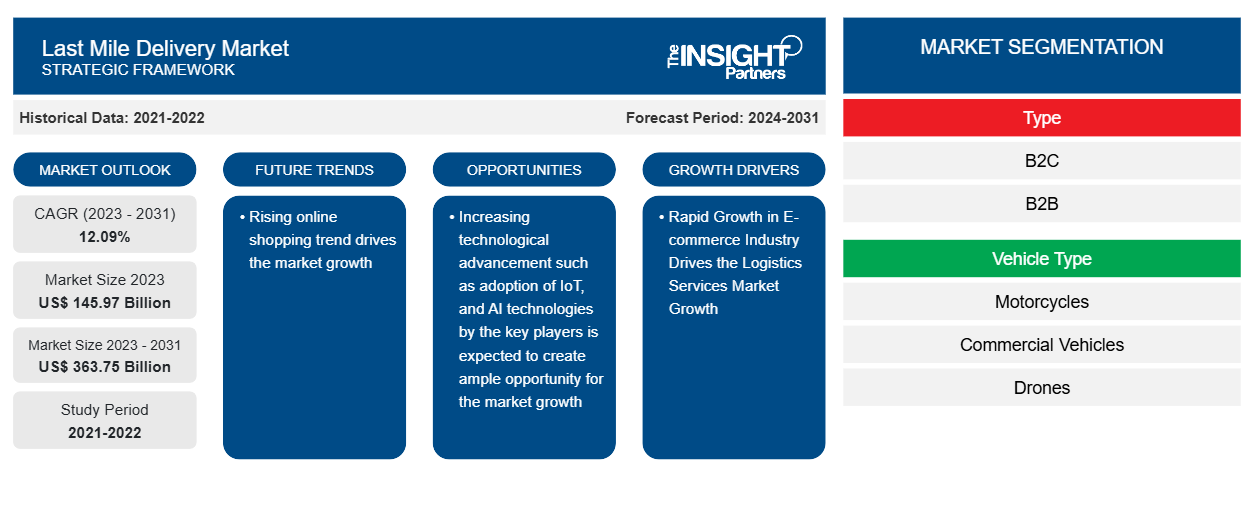Si prevede che le dimensioni del mercato delle consegne dell'ultimo miglio raggiungeranno i 363,75 miliardi di dollari entro il 2031, rispetto ai 145,97 miliardi di dollari del 2023. Si prevede che il mercato registrerà un CAGR del 12,09% nel 2023-2031. La consegna dell'ultimo miglio è la fase finale del processo di consegna in cui i prodotti vengono trasferiti da un centro di trasporto/magazzino alla loro destinazione finale, in genere una residenza personale o un punto vendita aziendale. Questa è la fase più importante del processo di consegna, poiché da essa dipendono l'esperienza di acquisto complessiva del consumatore e la fedeltà al marchio. Uno dei principali fattori che guidano il mercato globale delle consegne dell'ultimo miglio è la crescente penetrazione del settore dell'e-commerce in tutto il mondo. Lo shopping online in tutto il mondo sta crescendo rapidamente nei paesi in via di sviluppo come India, Messico, Brasile e Argentina.CAGR of 12.09% in 2023–2031. Last-mile delivery is the final step of the delivery process in which products are transferred from a transportation/warehouse center to their final destination, typically a personal residence or a business outlet. This is the most important phase in the delivery process, as the consumer's overall shopping experience and brand loyalty depend on it. One of the major factors driving the global last-mile delivery market is the increased penetration of the e-commerce sector across the globe. Online shopping across the globe is growing rapidly across developing countries such as India, Mexico, Brazil, and Argentina.
Analisi di mercato delle consegne dell'ultimo miglio
I fornitori di consegne dell'ultimo miglio trasportano più di 25 miliardi di pacchi a livello globale. La consegna dell'ultimo miglio è effettuata principalmente da fornitori di servizi logistici terzi tramite trasporto stradale e aereo. La consegna dell'ultimo miglio è il processo di consegna finale in cui il pacco viene consegnato ai clienti finali. La consegna dell'ultimo miglio include un magazzino fino alla porta del cliente, che è nota come consegna dell'ultimo miglio. La consegna dell'ultimo miglio è un processo di spedizione costoso e che richiede molto tempo, ma la soddisfazione generale del cliente è un criterio importante per le aziende chiave.
Panoramica del mercato delle consegne dell'ultimo miglio
Le aziende di logistica intervengono quindi e utilizzano software moderni per pianificare percorsi di consegna in base a criteri quali posizione, traffico e finestre di consegna. Per gestire varie ambientazioni metropolitane, le merci vengono trasportate rapidamente utilizzando un'ampia flotta di veicoli che vanno dai camion di base ai droni all'avanguardia e alle auto elettriche. La fase critica dell'"ultimo miglio" copre l'ultima tappa della consegna, in cui i prodotti vengono consegnati direttamente ai clienti, il che è spesso supportato da tecnologie di tracciamento in tempo reale per trasparenza e praticità.
Il mercato delle consegne dell'ultimo miglio costituisce una rete di diversi stakeholder, integrazioni tecnologiche, infrastrutture logistiche e comportamenti dei consumatori in evoluzione. Gli stakeholder principali sono i giganti dell'e-commerce e i rivenditori, e poi entrano in gioco le aziende di logistica. Queste organizzazioni si avvalgono dell'aiuto di aziende tecnologiche che offrono strumenti come la gestione delle consegne con ottimizzazione del percorso, tra gli altri. Oltre alle aziende di software, sono entrati in gioco molti produttori di droni e fornitori di servizi.integrations, logistical infrastructures, and evolving consumer behaviors. The primary stakeholders are e-commerce giants and retailers, and then logistics companies come into the picture. These organizations take help from technological companies that offer tools such as route optimization delivery management, among others. Apart from software companies, many drone manufacturers and service providers have come into the picture.
Personalizza questo report in base alle tue esigenze
Riceverai la personalizzazione gratuita di qualsiasi report, comprese parti di questo report, o analisi a livello nazionale, pacchetto dati Excel, oltre a usufruire di grandi offerte e sconti per start-up e università
- Scopri le principali tendenze di mercato in questo rapporto.Questo campione GRATUITO includerà analisi di dati che spaziano dalle tendenze di mercato alle stime e alle previsioni.
Driver e opportunità del mercato delle consegne dell'ultimo miglio
L'aumento del settore dell'e-commerce guida la crescita del mercato delle consegne dell'ultimo miglio
Il settore dell'e-commerce dipende principalmente dalla consegna dell'ultimo miglio per gestire le consegne dei pacchi ai clienti finali. La crescente domanda di acquisti online in tutto il mondo, insieme all'impennata della penetrazione di Internet in tutto il mondo, è un fattore trainante importante per la crescita del mercato della consegna dell'ultimo miglio durante il periodo di previsione. Si prevede che il numero di acquirenti online crescerà nei prossimi anni. Questo incremento ha influenzato direttamente i ricavi generati. Le vendite totali dell'e-commerce negli Stati Uniti hanno raggiunto i 595,5 miliardi di dollari nel 2019, con un aumento del 14,9% rispetto ai 518,5 miliardi di dollari del 2018. È anche uno dei tassi di crescita dell'e-commerce negli Stati Uniti più rapidi in sette anni, inferiore solo al guadagno del 15,5% anno su anno del 2017
Si prevede che la crescente adozione di sistemi di consegna senza equipaggio e la rapida adozione di tecnologie avanzate da parte delle aziende di logistica creeranno ampie opportunità di crescita del mercato.
In futuro, le aziende statunitensi hanno pianificato di distribuire milioni di veicoli di consegna senza conducente per le consegne di pacchi per soddisfare i crescenti requisiti del settore dell'e-commerce. Inoltre, c'è stata una crescente domanda di auto e veicoli di consegna compatti che vengono utilizzati nel settore dell'e-commerce on-demand da rivenditori, commercianti, ristoranti, hotel e supermercati. Le auto, come i veicoli passeggeri full-size, sono progettate per soddisfare i crescenti requisiti di consegna dell'ultimo miglio. Inoltre, diversi attori chiave del mercato stanno sviluppando e lanciando soluzioni basate sulla tecnologia avanzata per soddisfare i requisiti dei clienti per le consegne di pacchi o merci. Ad esempio, a settembre 2023, Magna International ha sviluppato e lanciato soluzioni di consegna autonome dell'ultimo miglio. La nuova soluzione è stata lanciata per le città metropolitane in tutto il Nord America.
Inoltre, a marzo 2022, Magna ha anche sviluppato il robot per consegnare una pizzeria nell'area di Detroit, negli Stati Uniti. Magna si è costantemente sviluppata per migliorare il business del servizio di consegna dell'ultimo miglio. Si prevede che tali iniziative lanciate dai principali attori del mercato creeranno ampie opportunità per il mercato globale delle consegne dell'ultimo miglio durante il periodo di previsione.
Analisi della segmentazione del rapporto di mercato sulle consegne dell'ultimo miglio
I segmenti chiave che hanno contribuito alla derivazione dell'analisi di mercato della consegna dell'ultimo miglio sono tipologia, piattaforma, applicazione e utente finale.
- In base alla tipologia, il mercato si divide in B2C e B2B.
- In base al tipo di veicolo, il mercato si divide in motociclette, veicoli commerciali, droni, veicoli terrestri autonomi e altri.
- A seconda degli utenti finali, il mercato è segmentato in generi alimentari, articoli essenziali per la casa/casalinghi e arredamento, pasti al ristorante, abbigliamento e vestiario, elettronica di consumo, giocattoli/hobby/articoli sportivi, grandi magazzini, gioielli, specialità, ricambi e accessori per automobili e altri.
Analisi della quota di mercato delle consegne dell'ultimo miglio per area geografica
L'ambito geografico del rapporto di mercato sulla consegna dell'ultimo miglio è suddiviso principalmente in cinque regioni: Nord America, Europa, Asia Pacifico, Medio Oriente e Africa e Sud America.
Si prevede che il mercato nordamericano delle consegne dell'ultimo miglio avrà la quota maggiore nell'area Asia-Pacifico e sta crescendo al CAGR più elevato durante il periodo di previsione. Il mercato nordamericano è guidato dalla rapida crescita dello shopping online, con un'impennata nella crescita del settore dell'e-commerce che guida la crescita del mercato globale delle consegne dell'ultimo miglio. Negli Stati Uniti, c'erano più di 274,70 milioni di persone che acquistavano beni online a partire dal 2023. Negli Stati Uniti, circa l'81% della popolazione totale degli Stati Uniti acquista beni tramite siti Web di e-commerce online. A partire dal 2023, il fatturato totale del settore dell'e-commerce negli Stati Uniti ha raggiunto 1.137 miliardi di dollari. Una crescita così rapida dello shopping online nei paesi nordamericani ha creato una crescita enorme per il mercato delle consegne dell'ultimo miglio.
Approfondimenti regionali sul mercato delle consegne dell'ultimo miglio
Le tendenze regionali e i fattori che influenzano il Last Mile Delivery Market durante il periodo di previsione sono stati ampiamente spiegati dagli analisti di Insight Partners. Questa sezione discute anche i segmenti e la geografia del Last Mile Delivery Market in Nord America, Europa, Asia Pacifico, Medio Oriente e Africa, e Sud e Centro America.

- Ottieni i dati specifici regionali per il mercato delle consegne dell'ultimo miglio
Ambito del rapporto di mercato sulle consegne dell'ultimo miglio
| Attributo del report | Dettagli |
|---|---|
| Dimensioni del mercato nel 2023 | 145,97 miliardi di dollari USA |
| Dimensioni del mercato entro il 2031 | 363,75 miliardi di dollari USA |
| CAGR globale (2023-2031) | 12,09% |
| Dati storici | 2021-2022 |
| Periodo di previsione | 2024-2031 |
| Segmenti coperti | Per tipo
|
| Regioni e Paesi coperti | America del Nord
|
| Leader di mercato e profili aziendali chiave |
|
Densità degli attori del mercato delle consegne dell'ultimo miglio: comprendere il suo impatto sulle dinamiche aziendali
Il mercato del Last Mile Delivery Market sta crescendo rapidamente, spinto dalla crescente domanda degli utenti finali dovuta a fattori quali l'evoluzione delle preferenze dei consumatori, i progressi tecnologici e una maggiore consapevolezza dei vantaggi del prodotto. Con l'aumento della domanda, le aziende stanno ampliando le loro offerte, innovando per soddisfare le esigenze dei consumatori e capitalizzando sulle tendenze emergenti, il che alimenta ulteriormente la crescita del mercato.
La densità degli operatori di mercato si riferisce alla distribuzione di aziende o società che operano in un particolare mercato o settore. Indica quanti concorrenti (operatori di mercato) sono presenti in un dato spazio di mercato in relazione alle sue dimensioni o al valore di mercato totale.
Le principali aziende che operano nel mercato delle consegne dell'ultimo miglio sono:
- C.E. Robinson
- DB SCHENKER Logistica
- Servizio pacchi unito
- Espresso giapponese
- Logistica CEVA
- DSV Aria e Mare
Disclaimer : le aziende elencate sopra non sono classificate secondo un ordine particolare.

- Ottieni una panoramica dei principali attori del mercato delle consegne dell'ultimo miglio
Notizie e sviluppi recenti sul mercato delle consegne dell'ultimo miglio
Il mercato Last Mile Delivery viene valutato raccogliendo dati qualitativi e quantitativi dopo la ricerca primaria e secondaria, che include importanti pubblicazioni aziendali, dati associativi e database. Di seguito è riportato un elenco degli sviluppi nel mercato per il mercato Last Mile Delivery e le strategie:
- A novembre 2023, Amazon.com Inc. ha lanciato il programma di flotta per le consegne dell'ultimo miglio in India che utilizza veicoli elettrici per i suoi fornitori di servizi di consegna. Nell'ambito di questo programma, l'azienda ha lanciato e adottato il veicolo elettrico a tre ruote di Mahindra Zor Grand per offrire le consegne dell'ultimo miglio di Amazon. (Fonte: DJI, comunicato stampa/sito Web aziendale/newsletter)
- Nell'ottobre 2023, Bringg, un fornitore di Delivery Management Platform, ha lanciato la piattaforma modulare ROAD per ottimizzare e gestire dinamicamente le flotte interne e automatizzare la consegna dell'ultimo miglio per creare un'esperienza fluida per autisti, spedizionieri e clienti. (Fonte: Flyability, comunicato stampa/sito Web aziendale/newsletter)
Copertura del rapporto di mercato sulle consegne dell'ultimo miglio e risultati
Il rapporto “Dimensioni e previsioni del mercato delle consegne dell’ultimo miglio (2021-2031)” fornisce un’analisi dettagliata del mercato che copre le seguenti aree:
- Dimensioni e previsioni del mercato a livello globale, regionale e nazionale per tutti i segmenti di mercato chiave coperti dall'ambito
- Dinamiche di mercato come fattori trainanti, vincoli e opportunità chiave
- Principali tendenze future
- Analisi PEST dettagliata
- Analisi di mercato globale e regionale che copre le principali tendenze di mercato, i principali attori, le normative e gli sviluppi recenti del mercato
- Analisi del panorama industriale e della concorrenza che copre la concentrazione del mercato, l'analisi della mappa di calore, i principali attori e gli sviluppi recenti
- Profili aziendali dettagliati con analisi SWOT
- Analisi storica (2 anni), anno base, previsione (7 anni) con CAGR
- Analisi PEST e SWOT
- Valore/volume delle dimensioni del mercato - Globale, Regionale, Nazionale
- Industria e panorama competitivo
- Set di dati Excel
Report recenti
Testimonianze
Motivo dell'acquisto
- Processo decisionale informato
- Comprensione delle dinamiche di mercato
- Analisi competitiva
- Analisi dei clienti
- Previsioni di mercato
- Mitigazione del rischio
- Pianificazione strategica
- Giustificazione degli investimenti
- Identificazione dei mercati emergenti
- Miglioramento delle strategie di marketing
- Aumento dell'efficienza operativa
- Allineamento alle tendenze normative





















 Ottieni un campione gratuito per - Mercato delle consegne dell'ultimo miglio
Ottieni un campione gratuito per - Mercato delle consegne dell'ultimo miglio